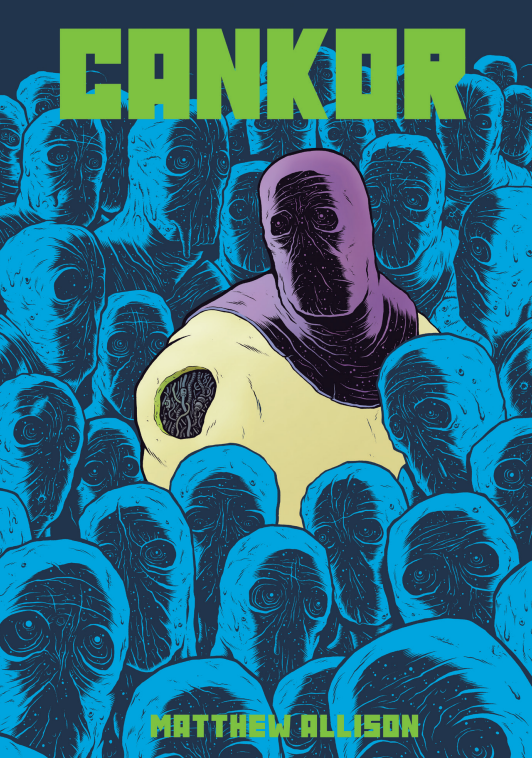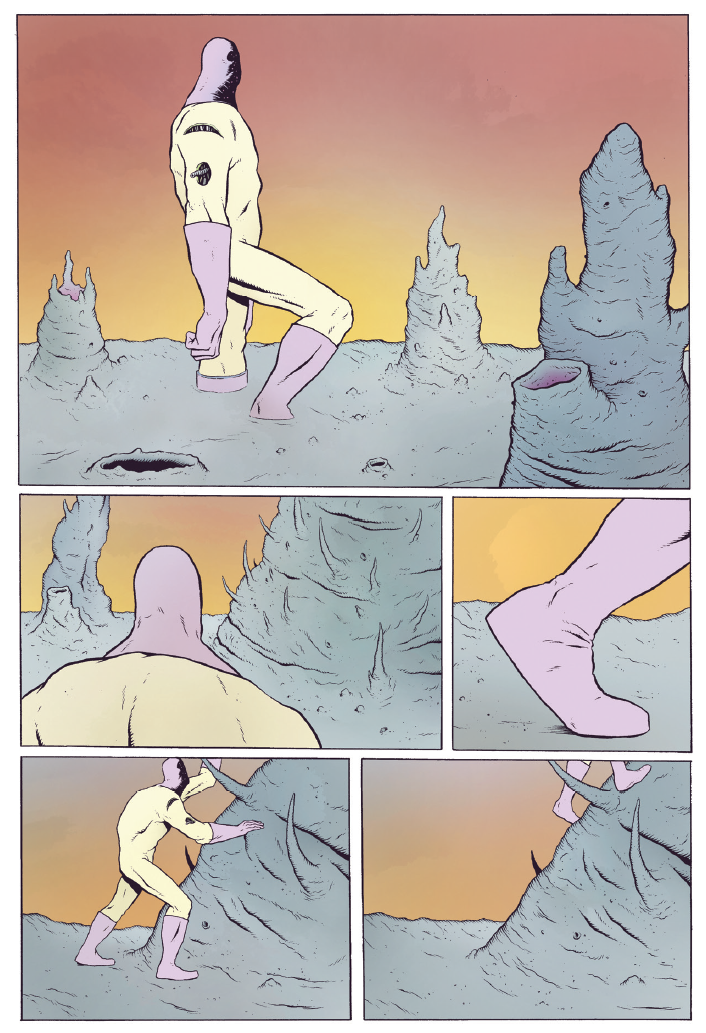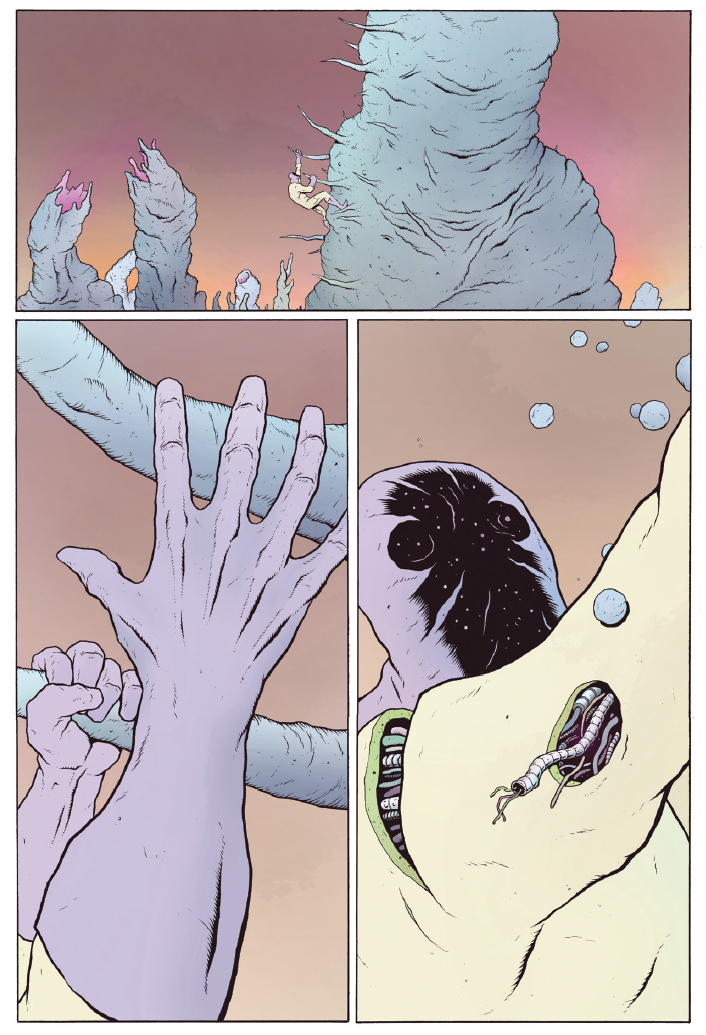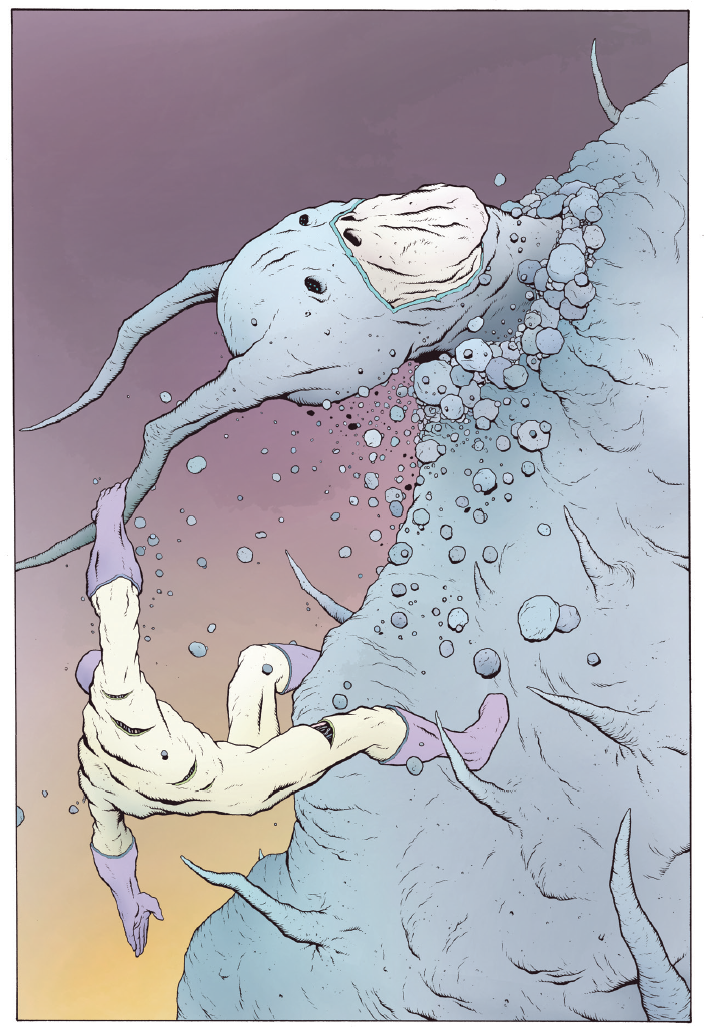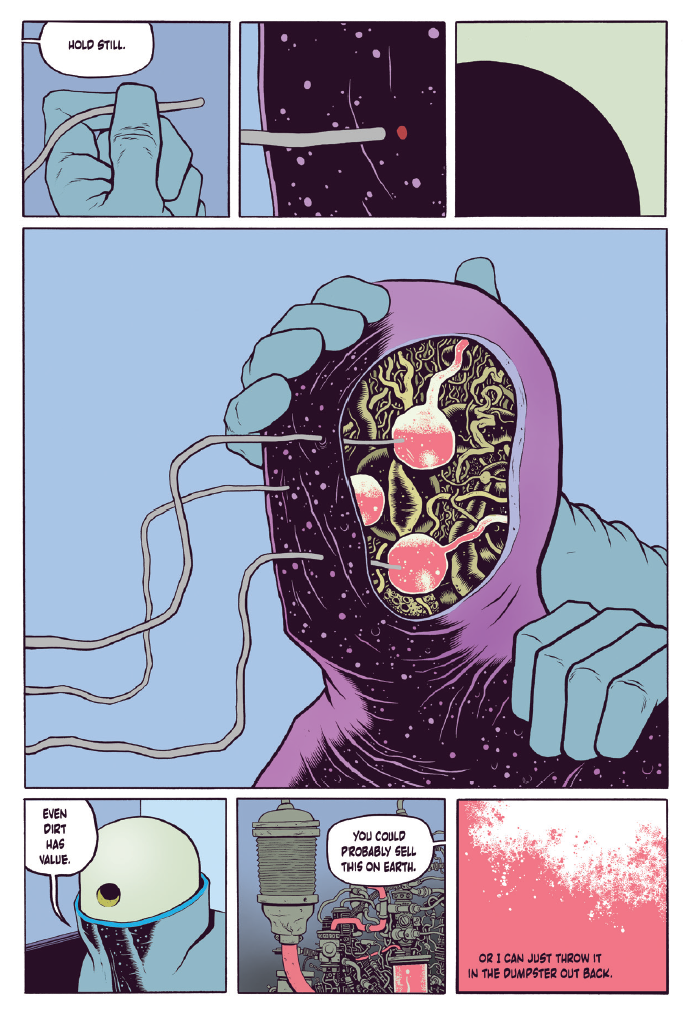Although I wish I could be cool enough to tell you all I knew him way back when, fact is the first time I ever saw Matthew Allison’s work was the tail end of 2022. When the buzz for Wizɘrd #2 reached my empyrean remove I ordered a copy of that most excellent zine and was quite pleased to have done so. The cover sold the book, in truth: two familiar figures, but not; superhero archetypes of yore distorted as if by a nightmare. A jaundiced celebration of the cartooning culture of a bygone era - a world of wonders, toxic and nostalgic in equal measure. A perfect thesis statement for that publication.
And now, as if by magic, I am confronted by the full measure of Allison’s talent, a massive hardcover devoted to a decade’s worth of material featuring the artist’s signature creation, the enigmatic Cankor. Self-published, without any backmatter for context or history, just a bunch of - well, I hesitate to say stories. There’s not a lot resembling conventional stories here, no beginning, middle or end. Cankor has no origin or lore; even just calling the character a character seems possibly tendentious. Cankor is an avatar, a strange creature in a strange landscape - imagine George Pérez drawing Teratoid Heights. There’s something really abstract, primarily personal at stake here, but most of these sequences are drawn as dark cousins to superhero stories. Ed the Happy Clown in the style of Liefeld. Allison’s work naturally draws such comparison - there are enough intentional and visible comparisons within the text itself to say that Allison the creator is fully conscious of just the kind of riffing he’s doing.
To wit, one of the best scenes in the book features a description of the central dynamic of Jim Woodring’s Frank, through the prism of a t-shirt graphic: “the cat has a pickle... on a stick. An’ the cats ridin’ on a hog, but the hog has the features of a man. He’s a Manhog!” That’s a productive kind of riffing, for a lot of people. Intertext is just another kind of texture, and Allison has a great deal of skill for texture. The sleek black of Charles Burns’ feathering can be seen on every page, that’s right up front. But not quite so pronounced, I was also taken throughout by a kinship with Chester Brown. Brown is himself a master of textural detail, or at least was back in his Yummy Fur days. I feel very much that, even if nothing else about his world makes sense, the cosmos Cankor inhabits feels to the touch a number of very certain ways. A visceral book, in physical terms.
As for who Cankor is - well, every character here is a version of Cankor. You’ve got a Cankorr, a Kankor, a Battle Armor Kankor, a Xankor, a Sterankor, a Tankor - they’re all constantly judging one another for crimes that are never properly enumerated. The “prime” Cankor, so to speak, is a well-muscled super type in a yellow leotard with purple boots and gloves. He also has a purple helm, but the helm is a deeper shade of violet, illustrated with a reflection of the cosmos. Sort of like how Jim Starlin used to draw cosmic awareness, back in the day. The only cosmic Cankor is aware of is being cosmically fucked up. Because let me tell you - this guy? Fucked up.
Here’s where I think those comparisons to Burns, and Brown, really come into focus. What Allison seems to share with so many of that first generation of alternative cartoonists is a fixation on the mortification of the flesh. If your work appeared on a can of OK Soda, it’s a good bet that you haven’t spent a lot of time idealizing the human form. Yes, yes, it was all so very Oedipal, the same reactionary impulse all the way back to R. Crumb - as little as Crumb ever had to do with the ostensible “mainstream” his work still depends on you knowing, somewhere in the back of your head, that this guy is drawing himself as a sad sack in bad clothes because so many other comics are virtual propaganda for the idealized physical form. And that means superhero books, but also just about everything else from Tintin to Archie. What else is Black Hole but Archie with some Cronenberg thrown in?
Cankor is a part of that discussion, of the place of the physical in comic book art, but Allison's referents are updated. Cankor is stuck in the middle of some kind of stream-of-consciousness existential horror - the narrative indicates at multiple points we’re joining sequences in media res. He’s always getting his body torn apart, dismembered, face melted - skin pulled off to expose bone and snaking circuit. The universe appears organic, alive, even the hard textures vaguely flesh-like, and the soft textures: pure nightmare fuel. Bodies are destroyed, limbs rent from torsos, medical examinations turned into hideous dissections. Miasmic energy snakes through the air like handfuls of worms. The universe is filled with living creatures pulsating in time to one another, albeit with anxiety and no trace of pleasure to be found.
Interspersed with long sections of deformed super-battles are passages set in something more resembling our quote-unquote real world - there’s a guy who really needs to spend money better and stop drinking so much, maybe get out of the house. Could be autobiographical, semi-autobiographical, or could just be the textures of memoir in fiction. I’m used to seeing cartoonists rip their guts out for artistic digestion, even if—especially if—the most self-excoriating work is also often among the most self-serving. Allison seems aware of that. Perhaps this guy is Cankor’s alter-ego? Perhaps Allison’s alter-ego. This guy eventually wins an Ignatz, which is both fairly prestigious and also a brick. Comics in a nutshell.
This is a volume for leafing back and forth, picking up various images in isolation, deducing plot from inference. Allison’s work is a pleasure to look at, even if the actual contents of the book are more unsettling than not. Allison as a creator is well-attuned to the ecosystem of comics art, even down to the emaciated critical apparatus: my favorite part was the bit with the pedantic Comics Journal reviewer who quits mid-stream because they’re sick of Gary sending them crap. Couldn’t possibly relate, at this point my appetite for crap is the stuff of legend. Anyway. Cankor is a striking book, filled with unique work. It’s more than the sum of its parts, but it's nonetheless fun to pick at the parts. Easy to get lost in these pages, just looking at those dynamite textures. Real Basil Wolverton hours.


